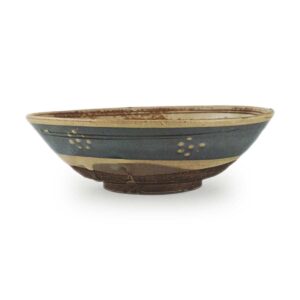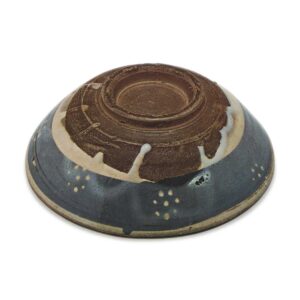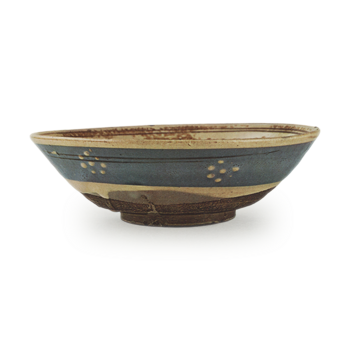

Height: 4.7 – 5.0 cm
Diameter: 15.5 cm
Foot diameter: 6.0 – 6.2 cm
Height: 0.5 cm
The term “E-Koryo” is also used to refer to a type of pottery that is appreciated for its beauty. It refers to a type of white porcelain with black designs from the Cizhou kilns, but this is a name that was borrowed from an older name that had already been given to this type of tea bowl. In the past, neither Korea nor China made a strict distinction between the two, so it seems that this type of tea bowl was thought to be from Korea, and was called “E-Koryo” because of the patterns on it. There are two types of E-Korya tea bowls: one with a plum blossom design in black glaze on a white background, and the other with a black background created by brushing on black glaze, and then a white design painted on top. The black background with white flowers is probably the more showy of the two.
The clay is a grayish-white, sticky clay typical of the Cizhou kilns, although it has become blackened by use. The potter’s wheel is also very fast, and the scraping marks around the foot are breathtaking. After the shape is formed, the foot is picked up and dipped in a thick white clay to apply the makeup. At Cizhou Kilns, the clay body is not white when it is fired, so this white makeup has been used since ancient times. This is the rule. Next, a thick mud with a high iron content, like demon plate, is brushed on to create a black band. Then, the same white mud as the makeup is used to create the pattern. The way this is applied makes me think that it was done with a brush, but looking at the way the grains are quite raised, it may have been applied with a spatula.
Then, on both the inside and outside, two black lines are drawn below the rim to finish off the design. As these lines are made of a different glaze, they also stand out clearly on the black background. After this, the same method as before is used to apply the overglaze. The glaze is made from feldspar, so it is somewhat cloudy. As a result, the white-glazed areas are white, and the black-brush-stroke areas have a tone similar to that of Nezumi Shino ware. And because the glaze is applied in a haphazard way, it extends to the part of the base material below the glaze, where it shows a glaze tone similar to that of Hagi or Gohon ware. This results in a very varied appearance.
That’s not all. Look at the photo of the bowl upside down. The glaze flows in many places, showing the beauty of white jade. And in places where the glaze is thick, the fine air bubbles gather together, giving the appearance of the skin of Shino ware. On the left side of the exposed body, you can see a different kind of mark from the dripping glaze, but this is the mark left behind after the excess white slip was washed off. It has become dirty and worn, but if you wash it, it will return to its original white color and clearly contrast with the grayish-white of the base material. This will give the landscape an even more interesting variation. It may be hard to see in the photo, but the area below the circle on the exposed part of the body (towards the front of the photo) is also exposed white makeup, and I think it would be a very beautiful sight if the white ground was exposed to this extent.
In contrast to the exterior, the interior is completely plain. The only thing that changes the appearance here is the “snake’s eye” in the middle, which has been scraped away to make room for the overglaze enamels. As it was scraped away after the glaze was applied, the boundary between the glazed area and the “snake’s eye” is very clear. In other painted Korean tea bowls, the glaze often peels off in this area, but this one is perfectly intact.
This type of painted Koryo tea bowl was probably made to order from Japan at the beginning of the Edo period. This is because there are no similar artifacts in China. In the Kansai region, this type of painted Koryo tea bowl is an indispensable item for the summer festival funa, along with Seto Karatsu (Kawa-geite) tea bowls. On the inside of the lid of the outer box, it is written by Toda Rogen (three generations before the Tanimatsuya Toda family) that this piece passed through the Katsuno and Takeda families before entering the Kajikawa family, and that it is said to be the first of its kind among the painted Korean wares, showing the high regard it was held in at the time.



